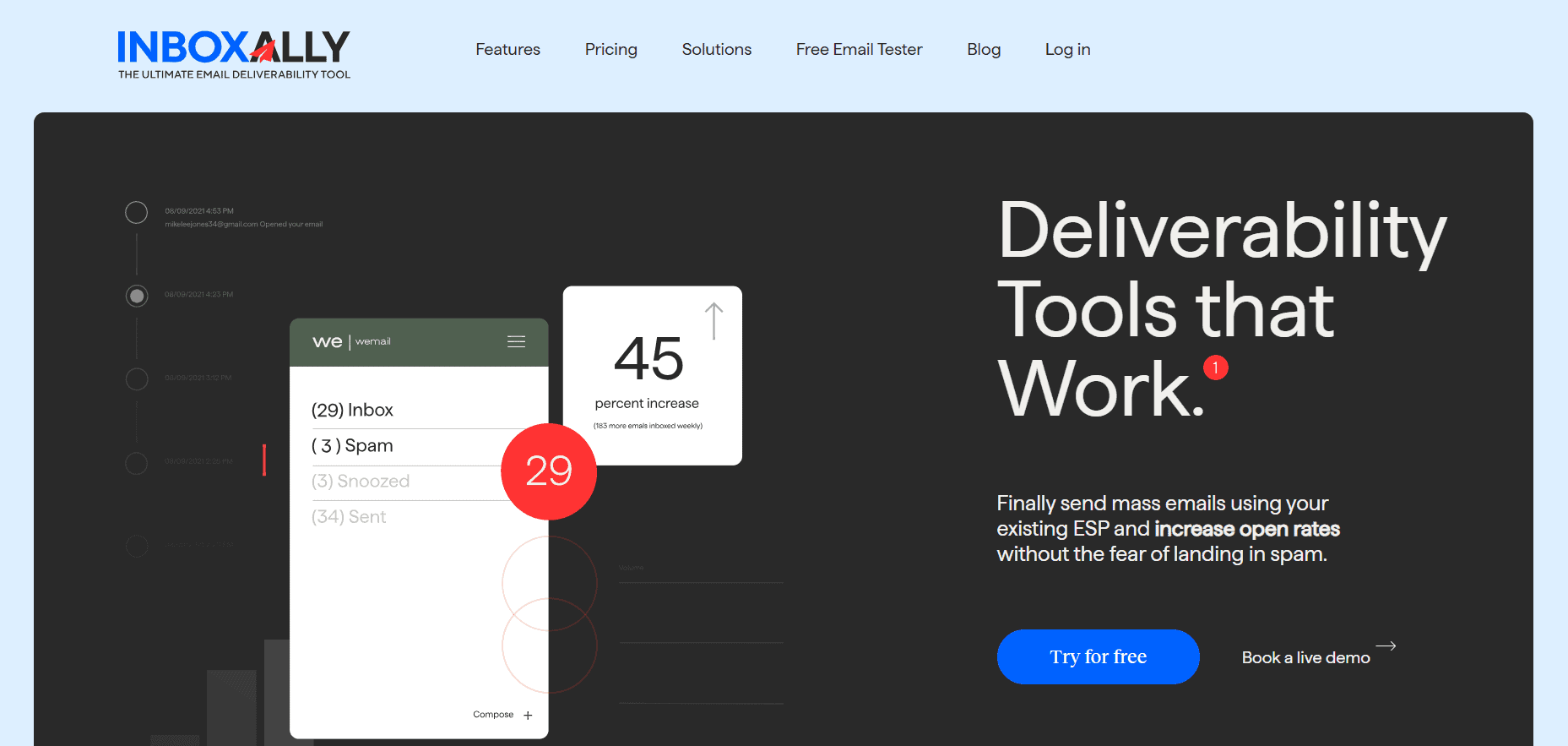- Allegrow Alternatives
- 1. InboxAlly — Best Overall Deliverability Platform
- 2. Warmy.io — Best for Automation and AI Workflows
- 3. Lemwarm — Best for Simplicity and Workflow Clarity
- 4. Warmbox — Best for AI-personalized Messaging
- 5. Folderly — Best for Visibility and Diagnostics
- 6. Mailreach — Best for Reliable Performance
- What Changed in 2025
- What it all Comes Down to...
Last Updated on November 28, 2025 by Ewen Finser
Allegrow walked so the rest of us could run. It gave structure to reports, compliance, and reputation charts — and made upper management sleep better.
But as of September 30th, 2025, Google removed reputation data from Postmaster Tools and changed the deliverability rules quite drastically. The old green bars vanished, and with them the illusion that deliverability could be “managed” from a dashboard.
Luckily, I’ve spent the past year testing nearly every platform that claims to fix inboxing issues, from enterprise suites to indie warm-up tools. Here are the ones that, in my experience, are worth checking out if you’re having a hunch that email service providers are not that into you anymore…
Allegrow Alternatives
1. InboxAlly — Best Overall Deliverability Platform
I ended up dropping Allegrow from my workflow the same week I tested InboxAlly because it finally showed me things Allegrow never could. I went from tracking compliance metrics to understanding inbox behavior at a foundational level. It’s not a warm-up gimmick or a reputation “scoreboard” but a live system that measures how inboxes treat your emails, and then helps you fix the root cause of any issues.
Check out our full InboxAlly review here: My 2025 InboxAlly Review: Does this help with email deliverability?
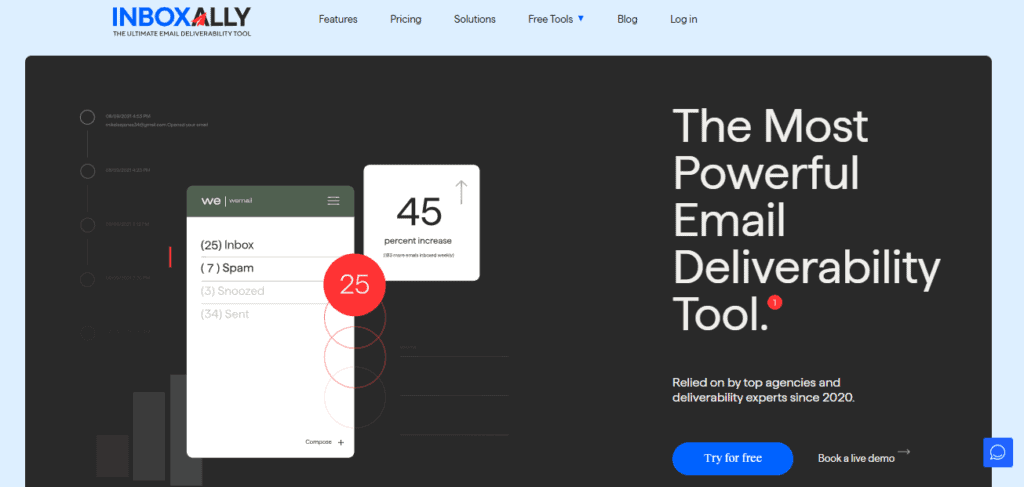
Key Features
- Reputation profiles that adjust dynamically to each sender’s behavior
- Engagement-based tracking that measures how your emails perform in real-world inboxes
- A visual analytics dashboard that connects campaign actions to placement changes
My Take
The biggest difference I noticed after switching was visibility. Allegrow gave me compliance indicators (SPF, DKIM, DMARC) and a clean “OK” sign. InboxAlly gave me evidence. I could see, for example, that my transactional emails were landing in Updates on Outlook but Primary on Gmail after tweaking the engagement rate. It wasn’t theory anymore — now I had feedback.
InboxAlly’s warm-up process isn’t just “sending fake interactions.” It uses verified seed inboxes that open, click, reply, and even rescue messages from spam, creating a behavioral footprint that mailbox providers recognize as positive. Within a few weeks, I noticed my engagement rates go up in live campaigns, not just in test mode.
The analytics side goes deeper than any tool I’ve used. Instead of dumping data into static reports, InboxAlly visualizes how each inbox, domain, or campaign behaves over time, including when something starts to decay.
Is it pricey? Yes. But I stopped wasting time wondering why campaigns underperformed. The ROI was clear as day once I factored in how many of my emails finally landed where they’re supposed to.
InboxAlly is the comprehensive suite I need to solve challenging deliverability problems across the board. It's like a triage hub for diagnosing and fixing email deliverability rates in one dashboard. I've tried a lot of tools, but this is the one I've stuck with.
Pros
- Reliable data
- Granular control
- Live placement data
Cons
- Steeper price point
- Takes a week or two to master
Who it’s for: InboxAlly works best for those who rely on email as an important revenue source. Agencies running multiple client domains, SaaS platforms sending lifecycle campaigns, or B2B teams doing heavy outreach will benefit most. It’s not cheap, but it’s a tool that pays for itself once your campaigns stop dying in spam.
2. Warmy.io — Best for Automation and AI Workflows
Warmy.io is one of those tools that just does its job and does it well. I’d call it the “set-and-forget” option of this list. The automation is freakishly consistent, the analytics are easy to understand, and it has saved me hours I used to spend manually monitoring inbox placement.

Key Features
- AI-powered warm-up that mimics real human engagement
- Domain Health Hub with blacklist and spam diagnostics
- Pre-launch deliverability tests
- Native integration with Google Postmaster Tools
My Take
Warmy makes you feel you have an assistant who never misses a day. Once you set it up, it calibrates itself by gradually scaling volume, balancing providers, and adapting to how each domain behaves. It’s not trying to be an end-all deliverability platform, but it keeps your sender reputation in check without any micromanagement.
While I was using it, the Domain Health Hub became one of my favorite features, hands down. It flags authentication issues, spam-trap risks, and even those subtle but telling changes in engagement that could affect reputation later. I especially like the pre-launch deliverability test, which shows which ISPs are likely to start filtering your messages before your campaign goes live. Trust me, it’s an insurance you start appreciating once you’ve had a big campaign go sideways.
Warmy is also surprisingly friendly for agencies. You can manage domains in bulk, monitor them all from one screen, and never worry about individual setups falling behind.
Pros
- Simple to use
- Reliable automation
- Great reporting
Cons
- Limited manual controls
- Data updates sometimes lag a few hours
Who it’s for: It’s great for marketers, agency operators, or anyone with multiple domains who prefers reliable automation over endless tweaking. Warmy is one of the best deliverability tools because it’s predictable and always on schedule.
3. Lemwarm — Best for Simplicity and Workflow Clarity
Lemwarm made deliverability refreshingly uncomplicated for me. If you get the jitters from seeing ten dashboards or having to decode deliverability jargon, you’ll probably like it a lot — just plug it in, sync it with Lemlist, and you’re up and running. It’s not trying to reinvent the wheel; it just makes deliverability painless and consistent.
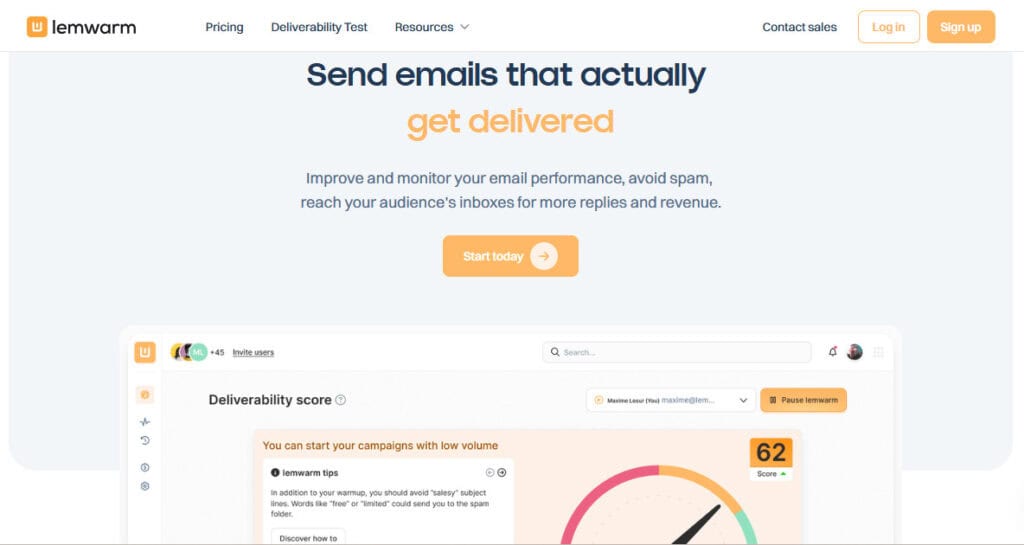
Key Features
- Personalized warm-up sequences that mimic real conversations
- Real-time deliverability and reputation tracking
- Seamless integration with Lemlist campaigns and reporting
My Take
If you already use Lemlist, adding Lemwarm feels like turning on a feature rather than learning a new tool. It syncs your sending limits, domain reputation, and warm-up volume automatically, all at once, with no spreadsheets and definitely no overthinking. The dashboard is very visual, and it tells you exactly what’s happening: how many warm-up emails went out, how many landed in spam, and when things are stabilizing.
I like how it translates deliverability into something a founder or operator can understand easily. You get color-coded trends and practical insights, so it doesn’t drown you in endless diagnostic graphs like many other tools do.
With that said, it’s not as detailed as I’d want it to be. If you’re handling several brands or domains (like I did), you’ll reach its limits quickly. It’s not built for multi-domain management or complex reporting, but rather to keep one pipeline clean and healthy.
Pros
- Easy setup
- Easy Lemlist integration
- Intuitive reports
Cons
- Lighter analytics
- Limited if you’re managing many domains
Who it’s for: Lemwarm is for cold emailers, indie founders, and early-stage teams already using Lemlist. It’s great if you’re sending from just a few inboxes and want a simple tool to maintain your deliverability. In a way, Lemwarm is the warm-up layer that keeps your Lemlist stack in top shape.
4. Warmbox — Best for AI-personalized Messaging
Warmbox might be the most human deliverability tool I’ve used because its AI does an outstanding job of writing back like a real person. Replies are conversational, and the tone adapts depending on the thread. It’s playful, light, and fast, which is exactly why it made its way onto this list.
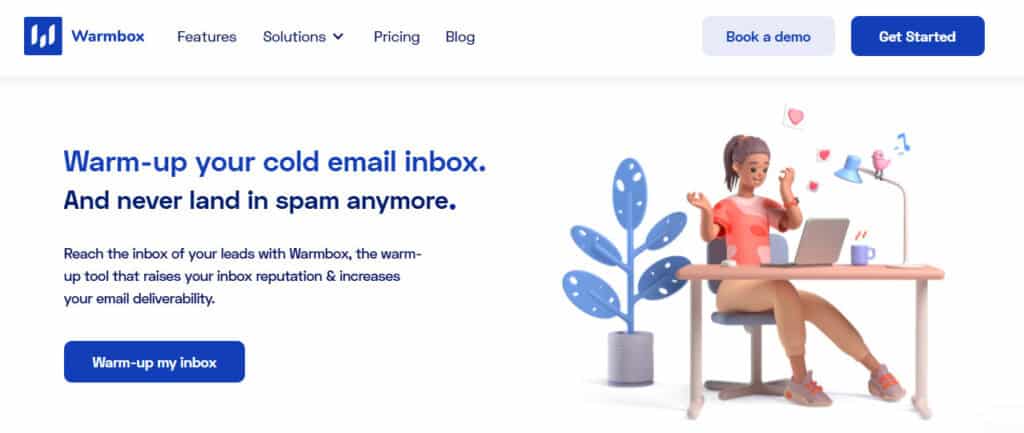
Key Features
- AI-simulated dialogues that sound human enough to fool you
- Private network of verified, active inboxes (no fake accounts)
- Customizable warm-up templates with real-time deliverability tracking
My Take
Warmbox was the first warm-up platform where I caught myself reading the warm-up threads. They’re oddly human because the replies reference content, add a touch of humor, and sometimes even “follow up” days later. That realism is what helps teach inbox providers that your messages belong with legitimate correspondence.
Setup takes minutes, literally. You connect your inbox, choose how aggressive you want the warm-up to be, and voilà, the AI handles the rest. It doesn’t overwhelm you with graphs or jargon — it gives you live metrics showing where your messages are landing and how reputation trends are moving.
Compared to something like InboxAlly or Allegrow, Warmbox isn’t trying to be a control tower. It’s more like a solopreneur-friendly tool that keeps your deliverability in shape without you having to touch a thing. The trade-off is scale. It’s great for individual operators, but less so for multi-domain setups that need consolidated reporting.
Pros
- Natural email tone
- Quick setup,
- Compatible with any ESP
Cons
- Not ideal for large-scale or enterprise senders,
- Fewer deep integrations
Who it’s for: Warmbox is mostly for consultants, freelancers, and small cold outreach operations that want their warm-up process to feel authentic and low-maintenance. It’s for people who care more about natural engagement than enterprise dashboards, and that’s what makes it great.
5. Folderly — Best for Visibility and Diagnostics
I imagine Folderly kind of as a full-body scan on my email setup. It’s detailed, data-rich, and borderline obsessive, but in the best possible way. It’s built to show you everything happening under the hood, from inbox placement to content-level spam triggers.
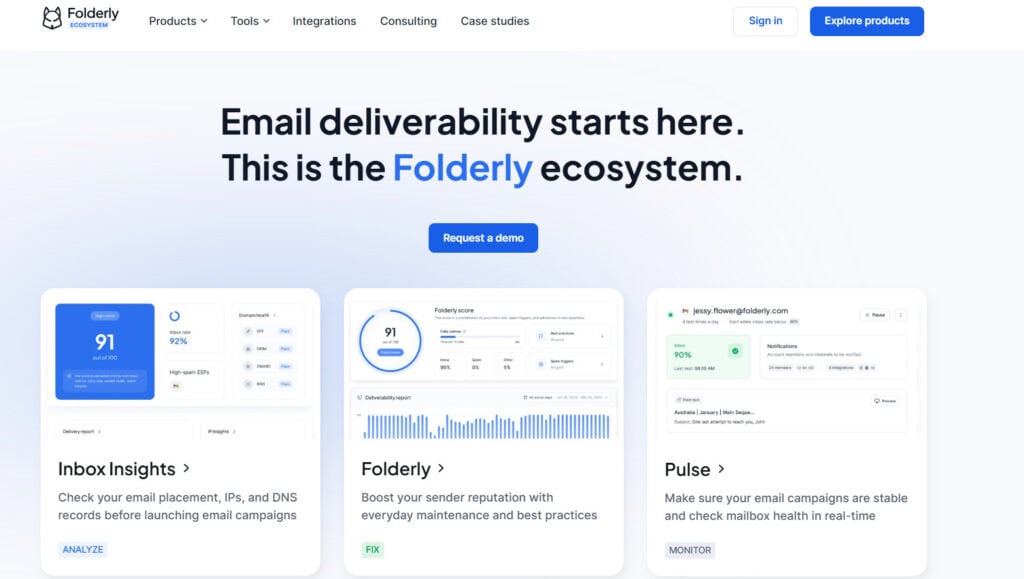
Key Features
- Inbox placement testing for all major ISPs
- Spam trigger detection and content scoring
- API access for integration with CRMs or analytics platforms
My Take
Folderly doesn’t just tell you if something’s wrong; it tells you why. When I first ran a few campaigns through it, the detail was almost overwhelming. I could see which phrases triggered spam filters, which providers filtered my messages to “Promotions,” and how reputation varied by domain. This kind of detail is what Allegrow’s compliance-style reports never quite achieved.
The interface feels built for professionals, and a bit complicated, at least at first. Each test generates a breakdown of content quality, authentication alignment, and spam heuristics. You can test specific templates or domains before launching a campaign to predict placement accuracy. For agencies, that’s gold as you can show clients hard data instead of hand-wavy deliverability talk.
Pros
- Deep visibility
- Detailed dashboards
- Actionable data
Cons
- Pricey for solo users
- Setup takes a bit of time to dial in
Who it’s for: Folderly is specifically made for agencies and consultants with more than one domain and the obsession to handle deliverability with precision and proof. It’s not cheap, but if your credibility depends on measurable results, it’s worth every cent.
6. Mailreach — Best for Reliable Performance
Mailreach won’t win you over with the looks, and that’s exactly why I like it. It’s the tool you pick when you want emails to land where they should and don’t want overbuilt dashboards or hype over features.

Key Features
- Real inbox engagement between verified sender accounts
- Clean, functional analytics dashboard
- Integrations for Gmail, Outlook, and custom SMTP providers
My Take
I’ve cycled through enough “AI-powered” deliverability tools to appreciate one that just works. Mailreach doesn’t drown you in metrics. It focuses on inbox placement and engagement, and it does those two things very well. Setup takes a few minutes, and from there it runs in the background, warming inboxes and giving you honest deliverability reports without turning your day into a dashboard marathon.
It’s not trying to predict the future or automate your strategy — it just gives you data you can trust. You’ll see where you land across providers, how reputation evolves, and whether your emails are improving week over week. Nothing more, nothing less.
I find Mailreach especially useful when I’m testing smaller client domains or new IPs. It’s stable, easy to explain, and doesn’t require babysitting.
Pros
- Affordable
- Stable
- Delivers what it promises
Cons
- Bare-bones visuals
- Limited depth compared to Folderly or InboxAlly
Who it’s for: Mailreach is perfect for small business owners or lean marketing teams that want to fix deliverability without taking on another enterprise learning curve. If you care about steady inbox results over bells and whistles, this is the one to keep on your roster.
What Changed in 2025
It’s wild how quickly the landscape can change. Not long ago, checking your Google Postmaster dashboard was a daily ritual, but as I already mentioned, on September 30, 2025, Google pulled both metrics from Postmaster Tools, and with it, the one piece of visibility most senders relied on to gauge deliverability health.
That single move forced a big change. Instead of glancing at a score, you now have to understand the story behind your emails; how engagement, authentication, and domain behavior interact. Tools that only “warmed up inboxes” are now basically relics. The market moved toward full-service deliverability platforms that simulate human engagement, track placement in real time, and analyze content risk from the inside out.
If you ask me, this change was overdue. A static dashboard never told you why your deliverability dropped, only that it did. Platforms like InboxAlly are filling in this gap by making inbox behavior visible again. Instead of guessing what Gmail thinks of you, you now see engagement metrics, response simulations, and content diagnostics that explain why something lands in Promotions instead of Primary.
Deliverability today is less about watching scores and more about context, control, and credible feedback loops. The tools that I’ve shown you in this article will all get you there, but the point is that the era of “set it and forget it” is gone.
What it all Comes Down to…
If you’re still running tests and waiting on pie charts to tell you whether you’re in trouble, you’re risking more than you have to. So treat deliverability as a moving system that requires tuning, testing, and watching patterns week to week. When it comes to deliverability tools, vanity metrics and slick UIs are passé. Pick the one that teaches you something every week, and you’ll be ten times better off.


